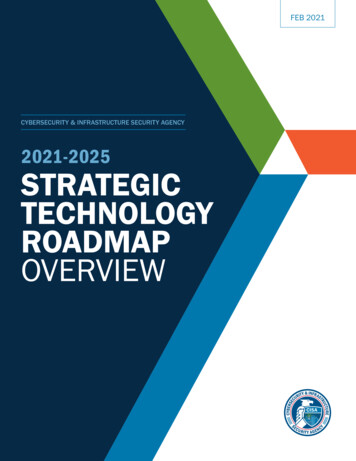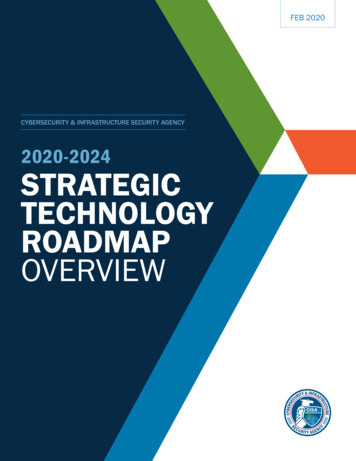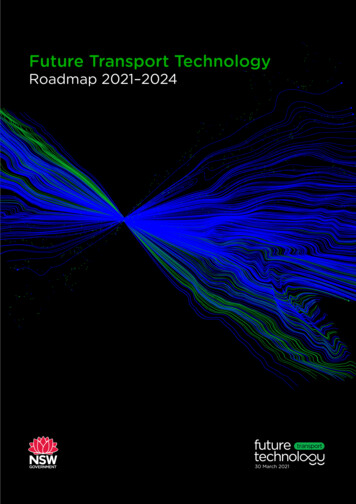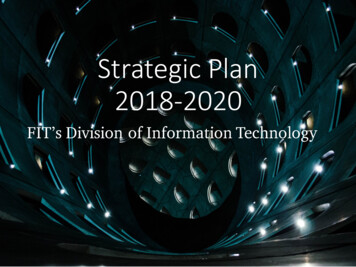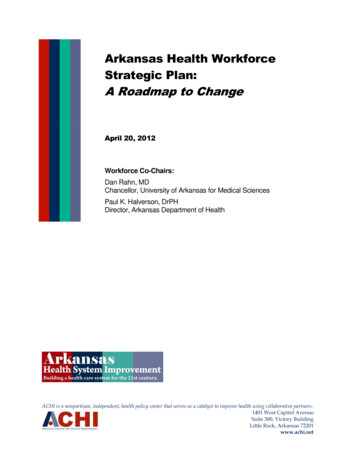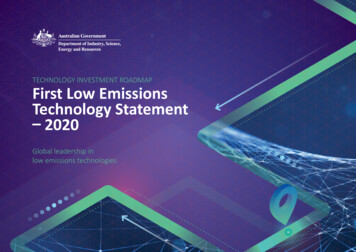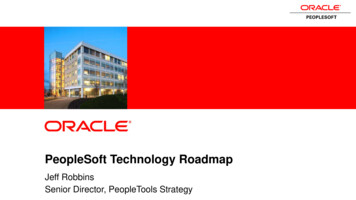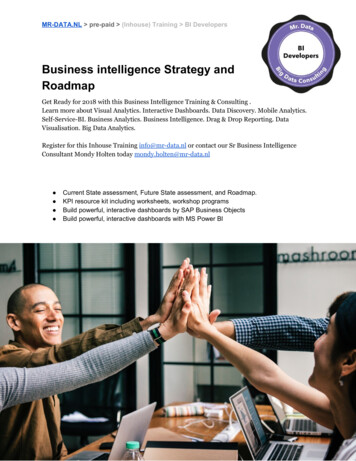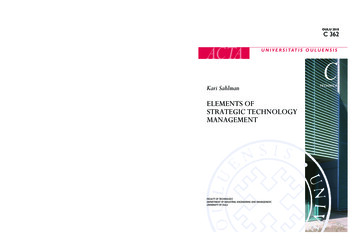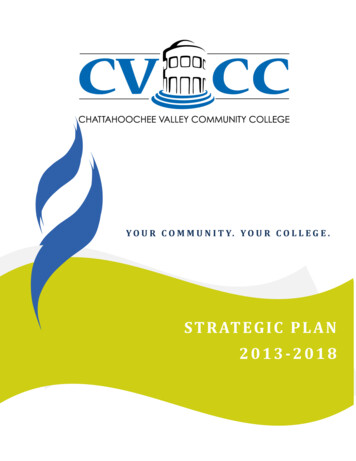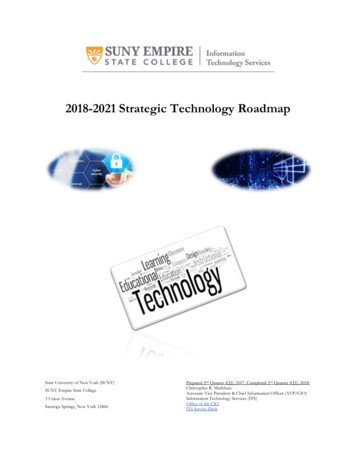
Transcription
2018-2021 Strategic Technology RoadmapState University of New York (SUNY)SUNY Empire State College3 Union AvenueSaratoga Springs, New York 12866Prepared 2nd Quarter (Q2), 2017, Completed 2nd Quarter (Q2), 2018:Christopher R. MarkhamAssociate Vice President & Chief Information Officer (AVP/CIO)Information Technology Services (ITS)Office of the CIOITS Service Desk
Table of ContentsCIO Executive Summary .4Information Technology Services Mission, Vision, and Value Statements 63 – Year Roadmap at a Glance .7Table 1: Strategic Theme 1 – Hardening and Capacity Building .7Objective 1.1: ITSM Frameworks and Best Practices .7Objective 1.2: Professional Standards, Acumen, and Philosophy .7Objective 1.3: Timely and Accurate Information Flows 8Objective 1.4: Enterprise Architecture planning, collaboration, and documentation. .8Objective 1.5: Customer and College-first Centric Operation and Support .8Objective 1.6: Hybrid Cloud Computing .8Objective 1.7: SUNY – ESC Wireline Network 9Objective 1.8: Quality Assurance and Continuous Improvement .9Table 2: Strategic Theme 2 – Leveraging the New Infrastructure .9Objective 2.1: Data Governance, End-User Security Classes and Permissions .9Objective 2.2: Managerial Finance and Resource Stewardship . 10Objective 2.3: Strengthened Network Architecture and Cyber Infrastructure .10Objective 2.4: Investment in Stakeholder Commitment . .10Objective 2.5: Improved IT Financial Planning and Forecasting . 10Objective 2.6: Improve Professional Development and Total Cost of Ownership 11Objective 2.7: Asset Management . 11Objective 2.8: NIST Cybersecurity Framework 11Table 3: Strategic Theme 3 – Innovating . 12Back to Table of Contents2
Objective 3.1: Increase digital media productions through co-sponsored and requirements . 12Objective 3.2: Enhance college wide ITS communication, training, and syndication . 12Objective 3.3: IT Governance and Persistent Value . 12Objective 3.4: ITS Quality Assurance and Continuous Improvement .13Objective 3.5: College-wide technical support . 13Objective 3.6: Learning Management System/Platforms . 13Objective 3.7: College-wide educational technology support 14Objective 3.8: Reconciliation of all digital media tools and processes . 14Locations of ITS Support and Service . 15SUNY Empire State College Tier 1 Map Strategic Plan . 16Aligning and mapping to the College Strategic Plan Objectives . 16Glossary of Terms . 18Endorsement and Patronage Back to Table of Contents233
Higher Education Information Technology Services of TomorrowCIO Executive SummaryI tell you, my fellow Americans, that if we learned anything from the collapse of theBerlin Wall and the fall of the governments of Eastern Europe, even a totallycontrolled society cannot resist the winds of change that economics and technologyand information flow have imposed in this world of ours.1The national and international higher education conversation has been in agreement for almost adecade now that the need to operate and compete globally has fully impacted higher education. Ofthe Carnegie Commission on Higher Education only a small minority of high volume researchactivity institutions are not incentivized in the same ways to change and innovate. For the rest of us,the new flat world2 of consumerism has cemented an economic demand upon largely teaching andlearning institutions to change and innovate, in order to maintain market relevance. Our students,both nascent and current, demand we shift our foci both administratively and pedagogically to themfirst, and all internal stakeholders secondary. Despite rhetoric preference, the new paradigm of thehigher education marketplace evinces that our students economically demand to be treated as such, atall stages of the student life-cycle.The value proposition of technology exists along the entire student lifecycle. Over the past 3 years,we have altogether reimagined an information technology services organization in service to theentire college, and its students. In year 1, FY15/16, we reimagined organizationally, by aligning ITSwith 21st century principles of IT organizational structure, represented by each neoclassical IT1Public Paper of the President of the United State: William J. Clinton, 1993, Book 2. Washington, DC: U.S.Government Printing Office, 1994, 2139–42.2Friedman, T. L. (2005). The world is flat: A brief history of the twenty-first century. New York: Farrar, Strausand Giroux.Back to Table of Contents4
reference discipline; (i.) Enterprise Infrastructure and Systems, (ii.) Enterprise Architecture andApplications, (iii.) Emerging and Educational Technologies, (iv.) User Technical Support, (v.)Information Security, and (vi.) Project Management. In year 2, FY16/17, we reimagined strategicallyand operationally by revamping, retooling, and reengineering our statewide infrastructure of voice,data, and video traffic, and embracing new partnerships to achieve cloud computing and enterprisesoftware innovations mapping to, and informed by, future state business processes, inadministration, enrollment management, and academics. And in year 3, FY17/18, we began ourreemergence as a 21st century technology organization in service to the entire college community.Over the next 3 years, as we continue to reemerge from our 2015–2018 operationally and financiallyaggressive technology strategy, mostly due to continuing enterprise software implementations (i.e.,CRM, ERP, Document Management, and LMS), a shift towards hardening capacity for users is key,if return on investment is to be achieved at a reasonable rate of return. Additional legacy systemsthat were left on the table during 2015–2018 due to resource allocation constraints, financial capitallimits, and organizational change capacity, must be brought to obsolescence. Retiring and innecessary instances, replacing, these legacy systems needs to be achieved through collaborativeengagement and design with administrative, enrollment management, academic leadership, andgovernance, to ensure these retirements and/or replacements support the strategic and operationalneeds of the entire college. This collaborative engagement and thought leader inspired design, is anessential element of hardening capacity and adoption for all our college stakeholders. Areemergence that targets college strategic goals and objectives first, will positively affect continuousimprovement by leveraging our new infrastructure, and unleashing innovation, not only within theOffice of Information Technology Services, but the college at large.“Innovation is not a big breakthrough invention every time. Innovation is a constant thing. But if you don’t have aninnovative company, coming to work every day to find a better way, you don’t have a company. You’re getting ready todie on the vine.”-Jack WelchBack to Table of Contents5
Empire State College’s Information Technology ServicesMission, Vision, and Value StatementsMission StatementThe Office of Information Technology Services serves to provide support, coordination,management, and leadership to the administrative and academic computing initiatives and activities ofSUNY Empire State College. Functioning as a service organization, the Office of InformationTechnology Services works collaboratively across the College community to: Enable and consistently improve SUNY Empire State College’s administrative technologiesto deliver quality education services and outcomes based on data-informed decisions. Provide innovative, connected, and sustainable technology environments and services whereteaching and learning can occur anytime and anyplace. Digitally connect SUNY Empire State College’s stakeholders together locally and globallythrough information and communication technologies. Collaboratively research and explore new and advanced modes of teaching and learning viaemerging technologies and tools related to 21st century higher education in support of SUNYEmpire State College’s mission, vision, and goals. Ensure secure, reliable, and stable enterprise technology system design, training opportunities,and support that mitigate modern cybersecurity risks.Vision StatementSUNY Empire State College Office of Information Technology Services will function in a unifiedmanner in the delivery and maintenance of academic, administrative, and general campus informationand communication technology services. Appropriate standards, processes, and procedures fortechnology service management and delivery will be followed to meet the priorities of the College,while keeping College information assets secure and available. Information Technology Services willbe responsive to the needs of its constituencies; provide technology leadership, solutions, and qualityservices; and be strategically aligned with the mission and direction of the College.Values StatementSUNY Empire State College Office of Information Technology Services affirms the following corevalues:1. An environment of integrity, mutual trust, transparency, and open communication.2. An ideal of excellence, fostered by a belief in quality, teamwork, and service.3. An esprit de corps personified by a positive attitude toward our work.Back to Table of Contents6
4. A spirit of courage and healthy risk-taking that nurtures technological creativity, innovation,and leadership.5. An appreciation and mutual respect for diverse and inclusive backgrounds and opinions.3-Year Roadmap at a GlanceStrategic Theme 1: Hardening and Capacity Building – How we partner and serve stakeholdersto internalize and adopt technology changes; ensuring adoption and incorporation into everydaybusiness. To ensure a sense of stability and aid employees to feel confident and comfortable with thenew ways of working.Strategic Theme 2: Leveraging the New Infrastructure – How we achieve environmentalvariation and affect continuous improvement to bring about optimal academic and administrativetechnology value.Strategic Theme 3: Innovating – How we empower our modern technology ecosystem to adopt avariety of strategies, both planned and intuitional, to export our products and services, and facilitatetechnology innovation.Table 1: Strategic Theme 1 – Hardening and Capacity BuildingObjective 1.1: IT Service Management (ITSM) Frameworks and Best PracticesMeasurement: Capabilities maturity model index ranking and ITIL FrameworkBaseline: 4 of 26 ITIL practices currently in placeTarget: Level three capabilities maturity model index (CMMI) ranking by end of plan and at least 1additional ITIL practice added each yearObjective 1.2: Professional Standards, Acumen, and PhilosophyMeasurement: Annual Performance Program review and assessmentBaseline: Zero cited items in the Key Actions Assessment of the 2015 – 2018 ITS StrategicRoadmapBack to Table of Contents7
Target: Level three CMMI ranking by end of planObjective 1.3: Timely and Accurate Information FlowsMeasurement: Quarterly reporting from each ITS group against strategic technology planBaseline: Current as of FY 2018Target: Delivered quarterlyObjective 1.4: Enterprise Architecture planning, collaboration, and documentationMeasurement: How many ESC divisional/departmental solutions have been architected andimplemented in current Enterprise Information Systems Architecture (EISA)Baseline: ESC EISA Timeline and Dependencies Gant chart in place by before close of FY2018Target: Retire (obsolescence), or replace, at least 3 legacy systems per yearObjective 1.5: Stakeholder and College-first Centric Operation and SupportMeasurement: Posted business hours and on an emergency (https://www.esc.edu/service-desk/)Baseline: Varies by ITS group (i.e., line of business – LOB)Target: Establish and achieve 100% compliance with service level agreement protocols across allITS groups/LOB’sObjective 1.6: Hybrid Cloud ComputingMeasurement: Secure hosting and backup of secondary enterprise applications and services thatsupport the administrative and business operations of the InstitutionBaseline: University at Albany Data Center design and buildoutBack to Table of Contents8
Target: Build College secondary data center operations by partnering with a tier 3infrastructure/rack space provider, preferably a SUNY recognized Research Education Network orIaaS providerObjective 1.7: SUNY – ESC Wireline NetworkMeasurement: Quarterly reporting of ESI progress, refresh, and topological mappingBaseline: 3-year planning cycle and overall EISATarget: Depict graphically the College WAN to illustrate how the ecosystem works in concert witha coherent technology roadmap, mission, and visionObjective 1.8: Quality Assurance and Continuous ImprovementMeasurement: Enterprise Information Systems Architecture (EISA) documented and updatedBaseline: Current EISA artifactsTarget: Bi-annual review and assessment of all College enterprise applicationsTable 2: Strategic Theme 2 – Leveraging the New InfrastructureObjective 2.1: Data Governance, End-User Security Classes and PermissionsMeasurement: Data Maturity Model and NIST CSFBaseline: ESC data governance group initiated in FY2016Target: Bi-monthly, cross-functional, data governance committee. A Change Advisory Board(CAB) in ServiceNow for data definitions, data cook book updates, and Role Based AccessBack to Table of Contents9
Control (RBAC) changesObjective 2.2: Managerial Finance and Resource StewardshipMeasurement: Bi-monthly reporting at directors meeting by directorBaseline: Services already available, quarterly reporting is notTarget: Comprehensive view of overall bud
emerging technologies and tools related to 21st century higher education in support of SUNY Empire State College’s mission, vision, and goals. Ensure secure, reliable, and stable enterprise technology system design, training opportunities, and support that File Size: 804KBPage Count: 23
